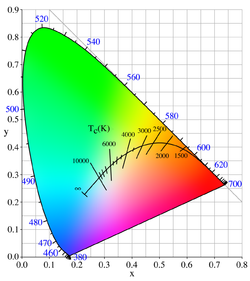- Chromaticity
-
 The CIE 1931 x,y chromaticity space, also showing the chromaticities of black-body light sources of various temperatures, and lines of constant correlated color temperature
The CIE 1931 x,y chromaticity space, also showing the chromaticities of black-body light sources of various temperatures, and lines of constant correlated color temperature
Chromaticity is an objective specification of the quality of a color regardless of its luminance, that is, as determined by its hue and colorfulness (or saturation, chroma, intensity, or excitation purity).[1][2]
In color science, the white point of an illuminant or of a display is a neutral reference characterized by a chromaticity; for example, the white point of an sRGB display is an x,y chromaticity of [0.3127,0.3290]. All other chromaticities may be defined in relation to this reference using polar coordinates. The hue is the angular component, and the purity is the radial component, normalized by the maximum radius for that hue.
Contents
In color science
Purity is roughly equivalent to the term "saturation" in the HSV color model. The property "hue" is as used in general color theory and in specific color models such as HSV or HSL, though it is more perceptually uniform in color models such as Munsell, CIELAB or CIECAM02.
Some color spaces separate the three dimensions of color into one luminance dimension and a pair of chromaticity dimensions. For example, the chromaticity coordinates are a* and b* in CIELAB, u and v in CIELUV, x and y in xyY space, etc. These pairs define chromaticity vectors in a rectangular 2-space, unlike the polar coordinates of hue angle and saturation that are used in HSV color space.
On the other hand, some color spaces such as RGB and XYZ do not separate out chromaticity; chromaticity coordinates such as r and g or x and y can be calculated by an operation that normalizes out intensity.
The xyY space is a cross between the CIEXYZ and its normalized chromaticity coordinates xyz, such that the luminance Y is preserved and augmented with just the required two chromaticity dimensions.[3]
See also
- CIE 1931 xy chromaticity diagram
- Chrominance
References
- ^ Emil Wolf (1961). Progress in Optics. North Holland Pub. Co. http://books.google.com/books?id=5n7yXmBusL0C&q=chromaticity+hue+purity&dq=chromaticity+hue+purity&pgis=1.
- ^ Leslie D. Stroebel, Richard D. Zakia (1993). The Focal Encyclopedia of Photography. Focal Press. ISBN 0240514173. http://books.google.com/books?id=CU7-2ZLGFpYC&pg=PA124&dq=chromaticity+hue+saturation+chroma+colorfulness+purity.
- ^ Charles A. Poynton (2003). Digital Video and HDTV: Algorithms and Interfaces. Morgan Kaufmann. ISBN 1558607927. http://books.google.com/books?id=ra1lcAwgvq4C&pg=RA1-PA219&dq=chromaticity+xyy#PRA1-PA219,M1.
External links
- Stanford University CS 178 interactive Flash demo explaining chromaticity diagrams.
Categories:
Wikimedia Foundation. 2010.
